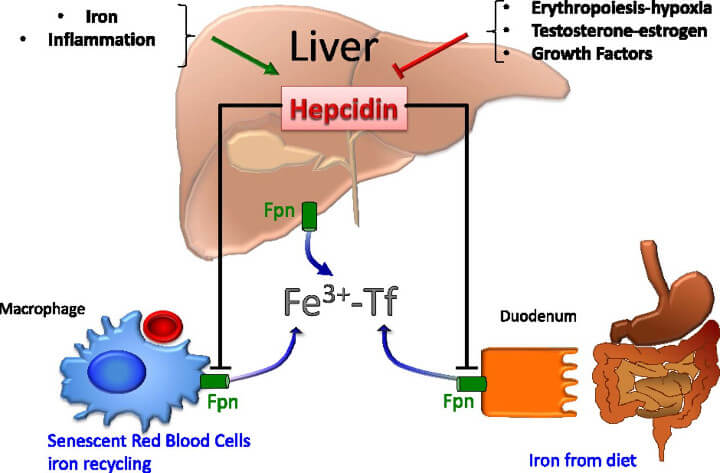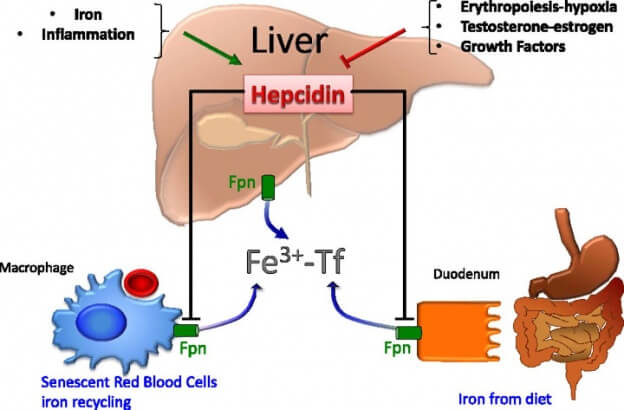Improving Gout & Iron Guidelines is aimed at anyone who has any interest in the effects of iron on uric acid and gout.
The purpose of this article is to improve GoutPal’s gout & iron guidelines.
Current guidelines about iron on GoutPal.com are:
-
Alternative Treatment For Gout – Blood Letting. The report on which this is based,
and a book (Facchini FS. The Iron Factor of Aging. Why do Americans age faster?), are reviewed it “Back to Bloodletting? Article in Journal of the American Geriatrics Society 52(9) · September 2004 DOI: 10.1111/j.1532-5415.2004.52425.x”. There is dietary advice for reducing available iron. But, it needs reviewing carefully with respect to gout. My article should probably be republished as “Can I donate blood with high uric acid” or similar. - Gout and Iron Revisited. Note, this is based on “Mascitelli L, Pezzetta F, Goldstein MR. Comment on: Gout: an independent risk factor for all-cause and cardiovascular mortality. Rheumatology (Oxford). 2010 Jul;49(7):1421-2; author reply 1422. doi: 10.1093/rheumatology/keq118. Epub 2010 Apr 27″‘ which should be cited correctly.
- Iron, Xanthine Oxidase, & Uric Acid
I would like these guidelines to help gout sufferers immediately. The guidelines must show which personal facts are important for managing iron and gout. Then, we can use the gout forum to help gout sufferers get personal management plans for iron.
At the moment, the gout & iron guidelines are fragmented. They also omit some relevant research. Once we have reviewed all relevant gout research, I will update the guidelines.
Gout & Iron Research Timeline
This is a partial list. The purpose of this article is to prompt readers to help fill this list with other gout and iron research.
| Title | Author | Journal | Notes |
| Anemia and the onset of gout in a population-based cohort of adults: Atherosclerosis Risk in Communities study | Mara A McAdams-Demarco et al | Arthritis research & therapy 14(4):R193 · August 2012 | Statistics show gout associated with anemia. Unexpected finding is explained by possibility of other diseases associated with anemia, or use of iron supplements. |
| Does inhibition of iron absorption by coffee reduce the risk of gout? | Mascitelli L, Goldstein MR. | Int J Clin Pract. 2011 Jun;65(6):713. doi: 10.1111/j.1742-1241.2011.02640.x. |
(3)=Hurrell RF, Reddy M, Cook JD. Inhibition of nonhaem iron absorption in man by polyphenolic containing beverages. Br J Nutr 1999; 81: 289–95. |
| Iron Behaving Badly: Inappropriate Iron Chelation as a Major Contributor to the Aetiology of Vascular and Other Progressive Inflammatory and Degenerative Diseases. | Douglas B Kell | BMC Medical Genomics 2(1):2 February 2009 | |
| Iron catalyzed oxidative damage, in spite of normal ferritin and transferrin saturation levels and its possible role in Werner’s syndrome, Parkinson’s disease, cancer, gout, rheumatoid arthritis, etc. | Johnson S. | Med Hypotheses. 2000 Sep;55(3):242-4. | |
| Effect of gradual accumulation of iron, molybdenum and sulfur, slow depletion of zinc and copper, ethanol or fructose ingestion and phlebotomy in gout. | Johnson S. | Med Hypotheses. 1999 Nov;53(5):407-12. | |

Iron & Inflammation is complicated – and this is without uric acid!
Gout & Iron Discussions
Old Iron and Gout Discussions
Old discussions about gout and iron often mentioned research, or raised interesting questions. Where appropriate, I will add these to the timeline above.
Here is a summary of key points from old gout & iron discussions:
- Gout and Iron – September 13, 2008
- Mentions gout and iron research:
Topic/Title Author Published Quotes, Questions & Notes Hepcidin: inflammation’s iron curtain. Drs. Hugh McGrath and PG Rigby at the Louisiana State Health Services Center in New Orleans. November 2004 issue of Rheumatology. “A broader phlogistic potential of iron towards the joint comes from a recent report that iron depletion by serial phlebotomies diminishes recurrences of gouty arthritis.” I used that “recent report” to write my famous blood-letting article. Iron and inflammation. Janis Kelly. Medscape Medical News. Review of McGrath and Rigby. About the role of iron in inflammation and in gout attacks. Ghio, Rao, Cooke, Milller and Holdal. Duke Univeristy Medial Center in Durham, North Carolina. September 1994 issue of Arch. Biochem. BioPhys. Key points (not verified):
- Iron plays a pivotal role in the inflammation process.
- Iron from meat and seafood is more readily absorbed than iron from vegetables.
- Ask doctor about switching from multivitamin fortified with iron, to one without.
- Read packaging to avoid added iron in food.
- Low-fat dairy and coffee contain substances that limit iron absorption in the intestines.
- There are foods that help the absorption of iron in the intestines and those that inhibit the absorption of iron.
- One doctor from India supported reducing blood for gout patients. His patient reported successful treatment of affected joints with leeches. The treatment was painless, and reduced gout pain symptoms.
Unanswered questions:
- How much blood donation is reasonable?
- Can blood still be donated for other purposes if not suitable for transfusion?
- Is the benefit of blood transfusion explained by expelling uric acid in the blood?
- Gout And Iron Supplements – May 25, 2011
A GoutPal member was concerned about iron in his multivitamin supplement.
I complained about UK breakfast cereal fortified with iron.
An American gout sufferer added:
In the U.S. ALL foods sold that are made with grains MUST be supplemented with iron. That’s EVERY bag of rice, every piece of bread, and every bag of pasta.
For men, it is iron poisoning, plain and simple. European studies have convincingly linked excess serum ferritin with heart disease.
- Uric Acid and Iron – September 19, 2008
- This starts with information about interactions between iron and uric acid. It is not referenced, but I suspect it is the Ghio research. In the discussion that followed, the following points were made:
- A suggestion that donating a pint of blood 4 times a year should be beneficial.
- 2 links for finding blood donation centers: USA redcrossblood.org and UK blood.co.uk.
- A suggestion that most gout patients would have blood ferritin levels above the 300-500 range, with 20 point reduction per blood donation.
- A reference to a PubMed study (not named!) that wheat grass is a better iron chelator than green tea.
- A couple of food Q’s please – December 7, 2009
- This was a discussion about the effects of the yeast extract, Marmite or Vegemite, on gout. We found that Marmite contains 25% RDA iron (1.8mg) in one 5g portion. We found no data on Vegemite. A reference to yeast extract suggests 0.2mg. We still need to confirm iron content of various yeast extract products.
In fact, we need to find clear evidence regarding the available iron content of all food. This is very complicated. Most data measures the iron content of food in the lab. Where’s the data that tells us how much iron will be absorbed from different foods as they are digested?
Current Gout & Iron Discussions
You can ask new questions about gout and iron in the gout forum.
I will add Gout Helpdesk messages about gouty arthritis and iron as feedback below.
Do you know any relevant research about gout & iron? Please share your findings in the comments below.

Here’s something relevant for World Blood Donor Day: Give Blood – Save Life – Stop Gout
> Is the benefit of blood transfusion explained by expelling uric acid in the blood?
Hmm.. I do not think so, I think the body processes far more uric acid than the 10% that might be reduced by phlebotomy, might lower it for a day or two but would soon return to the bodies required level, My belief is that the body creates & retains uric acid as an antioxidant depending upon the level of free iron (among other things). I seem to recall that somewhere I found the chemical pathway explaining how increased iron causes the kidneys to excrete less uric acid, will see if I can dig that out. I have a UASure URate meter; I can testify that my URate changes significantly at different times of the day and depending on what I have eaten but did not find any significant difference in uric acid before/after my blood donation.
I my case the link to iron came about because of food triggers. I found that green (frozen) peas are a serious Gout trigger, as are eggs and peanuts. The only link I can find between these foods is their high level of iron.
Earlier this year I was virtually bed-ridden for two months with gout in both legs. I was on a very restricted diet but gout still would not go away, that was until I made the connection to frozen peas. I was having a portion of peas almost every day thinking that green vegetables should be good for getting rid of gout. Once I had discovered the link and stopped eating peas I was up and about within a week.
The standard Serum Ferritin level in the UK is patently ridiculous, it is normalized from a population who subsist on iron (and niacin & thiamine) fortified foods. What would be interesting would be to find out the standard range for serum ferritin from a country which does not have fortified foods, maybe Sweden for example. Then again what about the incidence of Gout in Countries which do not fortify their food? Anyone know how the levels of Gout in non fortified Countries compares to fortified Countries?
Here in England the prevalence of gout has increased by 1000% since 1980, I have researched this and obtained all the figures for prescriptions during this period in the BNF classification of ‘Gout & Cytotoxic Induced Hyperiuicaemia’.
My personal problem is that I am in the UK and over here blood donation is restricted (apparently by law) to once every three months. Even then there are so many people wanting to donate blood (maybe for therapeutic reasons?) that there are not enough places, the wait to book a slot to donate is currently about nine months. The chances of finding a Doctor willing to do Therapeutic Phlebotomy seems to be zero so apart from leeches blood-letting is out.
I have managed to donate blood only once so far and I was gout free for nearly two months after doing that.
I added some notes about “Does inhibition of iron absorption by coffee reduce the risk of gout?” today. Because I think the references I noted are useful to anyone looking to manage iron with diet (though, they are possibly just the tip of the iceberg). Also, the full text of that iron & coffee article is very useful, as an introduction explaining how coffee is good for gout. But, iron is bad.